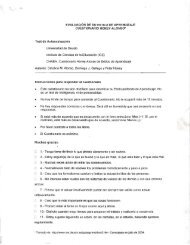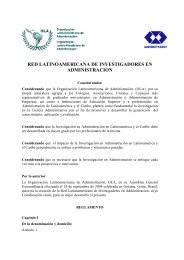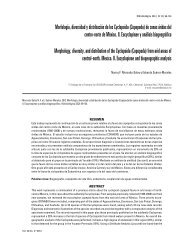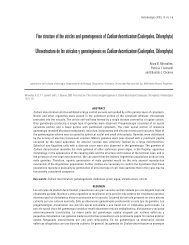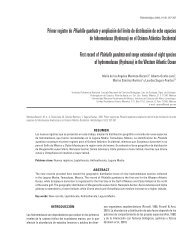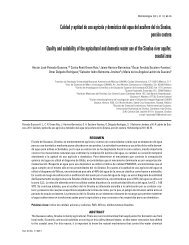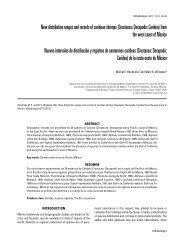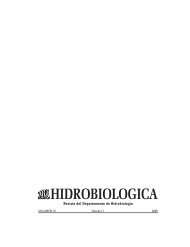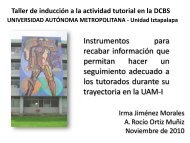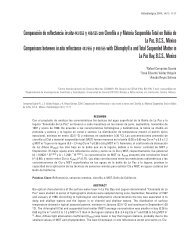Notes on some alpheid shrimps (Decapoda: Caridea) of Thalassia ...
Notes on some alpheid shrimps (Decapoda: Caridea) of Thalassia ...
Notes on some alpheid shrimps (Decapoda: Caridea) of Thalassia ...
You also want an ePaper? Increase the reach of your titles
YUMPU automatically turns print PDFs into web optimized ePapers that Google loves.
<str<strong>on</strong>g>Notes</str<strong>on</strong>g> <strong>on</strong> <strong>alpheid</strong>s from Mexican Caribbean 223<br />
INTRODUCTION<br />
Shrimps <strong>of</strong> the family Alpheidae, comm<strong>on</strong>ly known as snapping<br />
<strong>shrimps</strong>, are an abundant and ecologically diverse group <strong>of</strong> decapod<br />
crustaceans in most marine tropical and subtropical waters<br />
(Anker et al., 2006a), but are also distributed in cool-temperate<br />
(e.g., Anker & Komai, 2004), freshwater (De Grave et al. 2008),<br />
and brackish water habitats, such as mangroves and estuaries<br />
(Christ<strong>of</strong>fersen, 1984). Alpheids are distributed from the intertidal<br />
down to about a 1000 m in depth (see Anker et al., 2006a), but<br />
reach their greatest diversity in waters shallower than 50 m, particularly<br />
<strong>on</strong> coral reefs and adjacent habitats, e.g., sea-grass beds<br />
or sand flats with coral rubble. Many species are symbiotic with<br />
other organisms, such as sp<strong>on</strong>ges, anem<strong>on</strong>es, cnidarians, mollusks,<br />
echinoderms, annelids, fishes, and other crustaceans (Kim<br />
& Abele, 1988; Anker et al., 2006a).<br />
Several studies <strong>on</strong> the caridean fauna including the snapping<br />
<strong>shrimps</strong> have been carried out in the Caribbean regi<strong>on</strong>, most<br />
<strong>of</strong> them focused <strong>on</strong> their tax<strong>on</strong>omic and zoogeographic aspects<br />
(e.g., Armstr<strong>on</strong>g, 1949; Chace, 1972; Carvacho, 1979, 1982; Duffy,<br />
1996; Martínez-Iglesias et al., 1996, 1997; Vargas & Cortés, 1999;<br />
Anker, 2007; Anker et al., 2006b; Ríos & Duffy, 2007; Macd<strong>on</strong>ald et<br />
al., 2009); however, studies for the Mexican Caribbean are rather<br />
scarce, with Chace (1972) being the main reference presenting<br />
extensive tax<strong>on</strong>omic informati<strong>on</strong> <strong>on</strong> this group for the tropical<br />
western Atlantic, including the Yucatán Peninsula. Other important<br />
c<strong>on</strong>tributi<strong>on</strong>s are by Markham and D<strong>on</strong>ath-Hernández (1990)<br />
and Markham et al. (1990), who provided a synopsis <strong>of</strong> the shallow-water<br />
crustaceans <strong>of</strong> Quintana Roo, including several new<br />
records <strong>of</strong> <strong>alpheid</strong>s. Bri<strong>on</strong>es-Fourzán and Lozano-Álvarez (2002)<br />
reported <strong>some</strong> data about the <strong>alpheid</strong>s from Cozumel. The deep<br />
water caridean fauna was studied by Escobar-Bri<strong>on</strong>es and Villalobos-Hiriart<br />
(2003), who menti<strong>on</strong>ed three new records <strong>of</strong> snapping<br />
<strong>shrimps</strong> from the coast <strong>of</strong> Quintana Roo.<br />
800 µm in meadows <strong>of</strong> turtle-grass (T. testudinum) at a depth range<br />
<strong>of</strong> 0.4-1.0 m. Immediately after sampling, all the specimens were<br />
fixed in 10% formaldehyde and then transferred to 70% ethanol.<br />
The bottom was sand-mud with fragments <strong>of</strong> shells at Bahía de la<br />
Ascensión and Bahía del Espíritu Santo and sand in the Mahahual<br />
reef lago<strong>on</strong>. Additi<strong>on</strong>al metadata (currents, temperature, salinity,<br />
sediment type, and vegetati<strong>on</strong>) <strong>of</strong> these study areas can be found<br />
in Merino Ibarra (1986), Jordán-Dahlgren et al. (1994), Castellanos<br />
Osorio and Suárez-Morales (1997) and Suárez-Morales & Rivera-<br />
Arriaga (1998).<br />
The species treated here were arranged alphabetically;<br />
syn<strong>on</strong>ymies, material examined, geographic ranges, ecological<br />
notes, as well as new local records in the Mexican Caribbean<br />
are provided for each species. All specimens are deposited in the<br />
collecti<strong>on</strong> at the authors laboratory, in the Universidad Naci<strong>on</strong>al<br />
Autónoma de México (UNAM).<br />
RESULTS<br />
A total <strong>of</strong> 657 specimens from two genera and seven species<br />
were collected during the surveyed period. The genus Alpheus<br />
Fabricius, 1798 was the most diverse, with five species. Four species<br />
represent new records for the Bahía del Espíritu Santo, while<br />
two species are new records for Mahahual reef lago<strong>on</strong>.<br />
Order <strong>Decapoda</strong> Latreille, 1802<br />
Infraorder <strong>Caridea</strong> Dana, 1852<br />
During a study <strong>on</strong> the biology and ecology <strong>of</strong> bopyrid parasites<br />
<strong>of</strong> the caridean fauna based <strong>on</strong> recent field work in the<br />
Bahía de la Ascensión, Bahía del Espíritu Santo and the Mahahual<br />
reef lago<strong>on</strong>, <strong>alpheid</strong> <strong>shrimps</strong> were collected by trawling <strong>on</strong><br />
turtle-grass (<strong>Thalassia</strong> testudinum Banks ex König) meadows. In<br />
the present paper those <strong>shrimps</strong> are listed and <strong>some</strong> notes about<br />
them are provided.<br />
MATERIAL AND METHODS<br />
Field work was c<strong>on</strong>ducted at five stati<strong>on</strong>s in the Bahía de la Ascensión<br />
(19°30’-19°50’ N, 87°25’-87°50’ W), five in Bahía del Espíritu<br />
Santo (19°12’-19°25’ N, 87°41’-88°47’ W), and <strong>on</strong>e in Mahahual<br />
reef lago<strong>on</strong> (18°42.88’ N, 87°42.44’ W) al<strong>on</strong>g the central-southern<br />
coast <strong>of</strong> Quintana Roo, Mexico (Fig. 1), during July 1997, May and<br />
November 2001, May 2002, and January 2003. All specimens were<br />
collected with a Colman-Seagrove sledge net with a mesh size <strong>of</strong><br />
Figure 1. Central-southern coast <strong>of</strong> Quintana Roo, Mexico<br />
showing sites sampled (in black dots) (modified from Román-<br />
C<strong>on</strong>treras & Martínez-Mayén, 2010).<br />
Vol. 20 No. 3 • 2010



